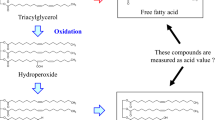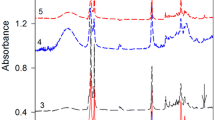Abstract
Isomers of conjugated linoleic acid from 7t9c through 12t14t can be induced by thermal treatment of triacylglycerol samples of 9c11t or 10t12c fatty acids in glass tubes. The formation of conjugated linoleic acids (CLAs) has been observed during thermal induction of the above-mentioned triacylglycerols at 250, 280 and 320°C. The concentrations of isomers formed in the mixture varied depending on the temperature and duration of the heating experiments. The objective of this study was to find a suitable thermal induction temperature and time that can produce most of the isomers of CLAs from the above-mentioned triacylglycerols. Such a mixture would give researchers a reference standard that can be used in the identification of CLAs in GC analyses of relevant samples. Fifteen-microlitre portions of the triacylglycerol samples containing 9c11t/10t12c fatty acid were placed in micro-glass ampoules, sealed under nitrogen and then subjected to thermal treatment. The glass ampoules were removed at regular time intervals, cut open, and part of the samples was analysed by infrared spectroscopy using attenuated internal reflectance technique. The remainder of the samples was subjected to derivatisation into their methyl esters. The methyl esters of the isomerised fatty acids were then analysed by gas chromatography after appropriate dilution in heptane. The results show that the thermally induced glyceride samples of 9c11t/10t12c fatty acids gave CLA profiles containing isomers ranging from 7t9c to 12t14t. However, the concentrations of the isomers are different depending on the duration of the thermal induction. It appears that [1,5] sigmatropic rearrangements and positional isomerisations take place in the heated mixtures. The rearrangements and positional isomerisations are accelerated by increasing temperature. The glyceride samples heated to 325°C form isomers within 30 min and provide a mixture of CLA isomers that can be used as reference sample containing the methyl esters of CLAs.








Similar content being viewed by others
Abbreviations
- CLA:
-
Conjugated linoleic acids
- ATR:
-
Attenuated total internal reflectance
- GC:
-
Gas chromatography
- FAME:
-
Fatty acid methyl esters
References
Ip C, Chin SF, Scimeca JA, Pariza MW (1991) Mammary cancer prevention by conjugated dienoic derivatives of linoleic acid. Cancer Res 51:6118–6124
Ip C, Chin SF, Scimeca JA, Thompson HJ (1994) Conjugated linoleic acid. A powerful anticarcinogen from animal fat sources. Cancer Suppl 74:1050–1054
Nicolosi RJ, Courtemanche KV, Laitinen L, Scimeca JA, Huth PJ (1993) Effect of feeding diets Enriched in conjugated linoleic acid on lipoproteins and aortic atherogenesis in hamsters. Circulation 88(suppl):2458
Shanta NC, Decker EA, Ustunol Z (1992) Conjugated Linoleic acids concentration in processed cheese. J Am Oil Chem Soc 69:425–428
Voorrips LE, Brants HA, Kardinaal AF, Hiddink GJ, Van den Brandt PA, Goldbohm RA (2002) Intake of conjugated linoleic acid, fat and other fatty acids in relation to postmenopausal breast cancer: the Netherlands Cohort Study on Diet and Cancer. Am J Clin Nutr 76:873–882
Belury MA, Vanden Heuvel JP (1997) Protection against cancer and heart disease by the dietary fat, conjugated linoleic acid: potential mechanisms of action. Nutr Dis Update J 1:58–63
Schrezenmeir J, Jagia A (2000) Milk and diabetes. J Am Coll Nutr 19(90002):176S–190S
Scimeca JA, Miller GD (2000) Potential health benefits of conjugated linoleic acid. J Am Coll Nutr 19:470S–471S
Parodi PW (1996) Milk fat components-possible chemopreventive agents for cancer and other diseases. Aust J Dairy Technol 51:24–32
Yurawecz MP, Roach JAG, Sehat N, Mossoba MM, Kramer JKG, Fritsche J, Steinhart H, Ku Y (1998) A new conjugated linoleic acid isomer, 7trans, 9 cis octadecanoic acid, in cowmilkcheese, beef and human milk and adipose tissue. Lipids 33:803–809
Destaillats F, Angers P (2003) Directed sequential synthesis of conjugated linoleic acid isomers from ∆7, 9 to ∆12, 14. Eur J Lipid Sci Technol 105:3–8
Cawood P, Wickens DG, Iversen SA, Braganza JM, Dormandy TL (1983) The nature of diene conjugation in human serum, bile and duodenal juice. FEBS 162:239–243
Berdeaux O, Voinot L, Angioni E, Juaneda P, Sebedio JL (1998) A simple method of preparation of methyl trans-10, cis-12 and cis-9, trans-11-Octadecadienoates from methyl linoleate. J Am Oil Chem Soc 75:1749–1755
Eulitz K, Yurawecz MP, Sehat N, Fritsche J, Roach JAG, Mossoba MM, Kramer JKG, Adlof RO, Ku Y (1999) Preparation, separation, and confirmation of the eight geometrical cis/trans conjugated linoleic acid isomers 8, 10-through 11, 13–18:2. Lipids 34:873–877
Jain VP, Proctor A (2007) Kinetics of photoirradiation-induced synthesis of soy oil-conjugated linoleic acid isomers. J Agric Food Chem 55:889–894
Destaillats F, Angers P (2002) Evidence for [1, 5] sigmatropic rearrangements of CLA in heated oils. Lipids 30:435–438
Christy AA, Xu Z, Harrington PB (2009) Thermal degradation and isomerisation kinetics of triolein studied by infrared spectrometry and GC–MS combined with chemometrics. Chem Phys Lipids 158:22–31
Mossoba MM, McDonald RE, Armstrong DJ, Page SW (1991) Identification of minor C18 triene and conjugated diene isomers in hydrogenated soybean oil and margarine by GC-MI-FT-IR spectroscopy. J Chromatogr Sci 29:324–330
Mossoba MM, Yurawecz MP, McDonald RE (1996) Rapid determination of total trans content of neat hydrogenated oils by attenuated total reflection spectroscopy. JOACS 73:1003–1009
Belton PS, Wilson RH, Sadehgi-Jorabegi H, Peers KE (1988) A Rapid Method for the Estimation of Isolated trans double bonds in Oils and fats Using FTIR combined with ATR. Lebensm Wiss Technol 21:153–157
Dutten HJ (1974) Analysis and monitoring of trans-isomerization by IR ATR spectrometry. J Am Oil Chem Soc 51:406–409
Lancer AC, Emkem EA (1988) Comparison of FTIR and capillary GC methods for quantitation of trans unsaturation in fatty acids methyl esters. Ibid 65:1483–1487
Christy AA (2009) Evidence in the formation of conjugated linoleic acids from thermally induced 9t12t linoleic acid: a study by gas chromatography and infrared spectroscopy. Chem Phys Lipids 161:86–94
Author information
Authors and Affiliations
Corresponding author
About this article
Cite this article
Christy, A.A. Isomerization of 9c11t/10t12c CLA in Triacylglycerols. Lipids 45, 733–741 (2010). https://doi.org/10.1007/s11745-010-3452-x
Received:
Accepted:
Published:
Issue Date:
DOI: https://doi.org/10.1007/s11745-010-3452-x




